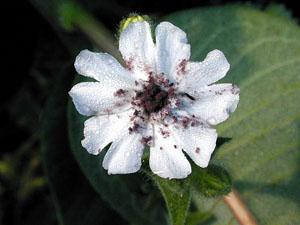August 25, 2010
Challenging the widespread belief that rare and endangered plants and animals are unhealthy, a new study has found they in fact harbor a lower number and diversity of disease-causing parasites than non-threatened, close relatives of the same family, according to Amherst College biology professor Michael Hood and his research team.
 The dark spores of anther smut on Silene alba.
|
“We still have much more to study to fully understand this discovery, but this certainly contradicts the widely held notion that disease is a major accelerant of species decline,” said Hood of the group’s findings, which were published by the journal Oikos on its website. “Combined with the loss of habitat, it is probably other ‘extinction vortex’ factors—such as loss of genetic diversity or disruption of reproduction processes—that cause many species to die out, not disease.”
Using information from the collections in natural history museums around the world, the U.S. Department of Agriculture databases and their own field work, Hood, former student Amanda K. Gibson ’08 and postdoctoral fellow Jorge Mena-Ali analyzed data from more than 42,000 flowering plants in the Silene genus for the destructive “anther smut” fungus. Anther smut, said Hood, is a model disease to study, because it is easy to see—it replaces the plant’s pollen with dark fungal spores—and because it is widely distributed in natural plant communities. In addition, it is harmless to humans and agriculture and safe for Hood and his team to handle.
The group’s major finding was surprising: Naturally occurring anther smut disease was significantly less frequent in threatened species than in non-threatened species of Silene.
What’s more, looking across all endangered U.S. plant species, the team found fewer pathogens and parasites, making endangered species as a group less diseased overall.
Hood hypothesizes that this could be because endangered species tend to have smaller, fragmented, physically isolated populations that make the maintenance and transmission of diseases more difficult.
But that doesn’t mean that the individual plants are more resistant to disease; when pathogens were introduced, members of the endangered species were just as likely become infected, said Hood, adding that the results were applicable to animals as well. And because the endangered species are less exposed to disease, they might be less likely to maintain costly immunities than plants that are regularly exposed.
That means that scientists and naturalists should carefully consider how they approach “saving” an endangered species of plant or animal, said Gibson, a former Fulbright scholar and National Institute of Allergy and Infectious Diseases researcher who is about to begin a Ph.D. program in the fall.
 |
“There has been a long-standing debate over the risk posed by infectious disease to endangered, vulnerable and threatened species and how this risk should be incorporated into conservation management programs,” she explained. “Many conservation initiatives work to grow the size and genetic diversity of endangered populations by introducing captive-bred individuals, translocating individuals or merging several small populations. However, our finding that small, isolated populations of endangered species have diminished exposure to pathogens suggests that, prior to enacting these policies, we must weigh the disease risks that increased population size and increased contact with foreign individuals pose to endangered populations.”
That’s not to say that the endangered species should be considered lost causes either, added Hood. “What this does show us is that there many important factors to think about when restoring an endangered species, beyond just building up the numbers, and chief among them is maintaining resistance to disease.”